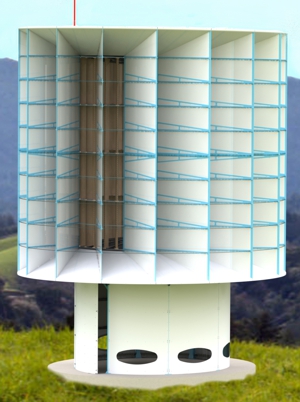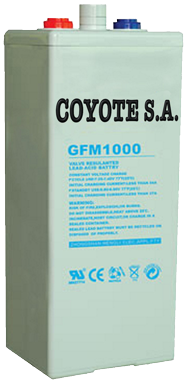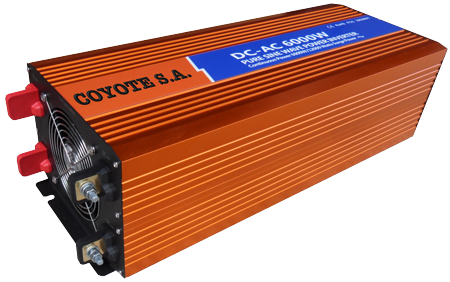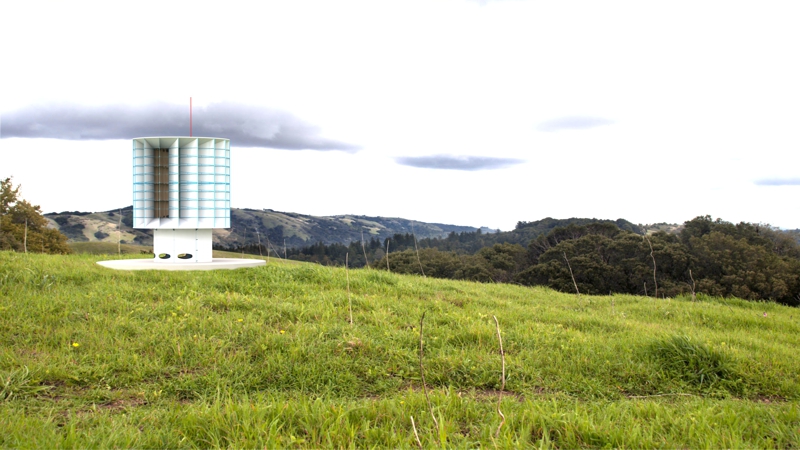

 |
 |
|
|
Phone:+86 13333092057 Email: iasos@iasos.eu |
Phone:
+30 6999398373 Email: coyote@iasos.eu |
| Vertical
axis wind turbine:
"Iasos III". |
Nominal
power: 4 KVA |
| Download |
 |
||
| Equipment
NOT included in the wind turbine
|
|
Batteries.
|
|
Batteries
are not included in the equipment of the wind turbine. The buyer should
procure batteries himself from his own local market.
The
technologically available solution for storing the electricity produced
by the wind turbine is the use of batteries. By storing the generated
electricity in batteries during the windy period, you will have electricity
available during the non-windy periods. |
 |
|
Based
on the nature of their electrolytes, cylindrical cell batteries are divided
into two types:
- Lead, immersed in electrolyte (sulfuric acid) (electrolyte type FLA). It is the OPzS battery type. The electrolyte in these batteries is in liquid form. OPzS batteries require constant checks and maintenance, which may not be pleasant for some people. Also, the risks of leakage, explosions and domestic accidents increase. OPzS batteries have openings at the top through which distilled water must be added. These openings have often been replaced with a self-regulating valve. - Lead immersed in thick GEL electrolyte (sulfuric acid with added silicon) (electrolyte type VRLA). It is the OPzV battery type. The batteries are sealed, do not need constant checks and do not emit fumes or gases. They are often called silicon batteries. To store the electricity generated by the "Iasos" wind turbine, you need 24 OPzV batteries. The batteries must be connected in series so that the total rated voltage is: 2 dcv X 24 pieces = 48 dcv To select the battery capacity, the best solution is to download from our company's website and use the special free software. To choose the capacity of the batteries you will buy, you have to decide on the one hand how many days of absolute apnea you want to have stored electricity and on the other hand what your electricity consumption will be for each day. If for example each battery has a capacity of 500 Ah, then the total energy that can be stored is 48 dcv x 500 Ampere = 24 Kwh. However, of this stored energy only 80% can be used. Therefore, 48 Kwh x 80% = 19.2 Kwh. You should also take into account that both the "charger controller" and the "inverter" work by consuming energy from the batteries. Therefore the available stored energy, in reality, is about 18 Kwh. If your consumption is 18 Kwh, then the stored electricity is enough for one day. |
|
|
"Inverter".
|
|
The
"inverter" is not included in the equipment of the wind turbine.
The buyer should procure the inverter himself from his own local market. If you use batteries, to store the electricity produced, to use the stored electricity you need an electronic device called an "inverter". The electric current stored in the batteries has a voltage of 48 dcv and is a direct current. Homes use alternating current with a voltage of 220 acv and a frequency of 50 Hz or a voltage of 110 acv and a frequency of 60 Hz. The "inverter" is the device that does this conversion of electricity. Therefore the input to the "inverter" is 48 dcv and the output 220 acv or 110 acv. |
 |
| Since
almost always in the electrical equipment of the buildings there is some
device containing an electric motor, the "inverter" should be
of the "pure sine" type. Otherwise, you may experience problems
with the electrical equipment you already have. To choose the power that the "inverter" should have to meet your electricity needs, we recommend using the calculation software found on our website. The logic to follow for selecting "inverter" is based on the concept of "peak consumption". If, for example, your daily consumption is 17 Kwh, this does not mean that you need an "inverter" with a power of 17 Kw. In every installation, which you want to electrify with green energy, there are many electrical devices with different power. You must record, on a piece of paper, these devices and the corresponding power of each one. Then you have to choose which of the power-hungry devices (devices with a lot of power) you want to be active at the same time. In other words you have to calculate the maximum power you want to have available at any time of the day. For example, if you want to use an electric cooking oven (3 Kw), a portable hair dryer (1 Kw) and an electric water pump (2 Kw) at the same time, then the "peak consumption" is 3 + 1 + 2 = 6 Kwh. In this case the "inverter" should be slightly larger than 6 Kw. But if you plan your consumption better and do not use the electric cooking oven at the same time as the water pump, then the "peak consumption" is substantially reduced... Based on this logic, you can make calculations yourself and come to the conclusion of what power the "inverter" you need should have. The more powerful the "inverter", the more expensive it is... |
|
 |
 |